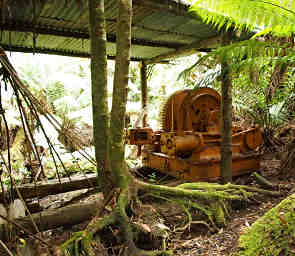
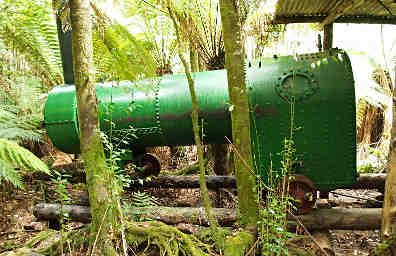
The Frappells had told us we would enjoy the Huon River Valley, and especially the "Air Walk," an elevated structure that allowed you to walk around part way up in the canopy. Dona had another motive for heading down that way -- she wanted to visit a woodturner down there, and see if she could locate some veneer from Tasmanian native trees like Blackwood. In addition, the Huon Valley is where a lot of fruit is grown, and we figured we would pick up some fresh apples. Frapps told us to look for "xxx" apples.
We headed in the general direction of the Air Walk. It is a long ways up a winding road in the state forest reserve, an area of commercial timber which has been and is being logged fairly heavily. As we wound our way up, we stopped at some of the interpretive sites along the way.
The first site wound a short ways into the trees, where we came to some old machinery relics. The sign said "The boiler, the winch, and the six-foot track." The picture below is of a steam locomotive that ran on wooden rails, and a winch used to drag logs up out of the bush. The earliest logging in this part of Tasmania took place in the mid 1800s, and everything came in originally on something riding the six foot wooden rails.
 |
 |
| Early 1900s Logging Winch | Early 1900s Steam Locomotive on Wooden Tracks |
There were a few large Eucalyptus trees left. As a timber tree, they must be a bit difficult to work with, as their trunks tend to not be round, and often are burned out. But the upper part of the tree looks great.
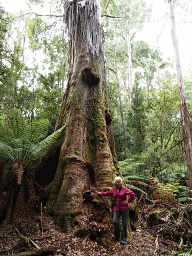 |
| Dona by Big Eucalyptus |
We stopped and took a short walk up a small creek. It was temperate rainforest country, and there was moss and ferns and fungus everywhere.
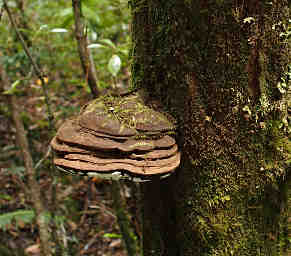 |
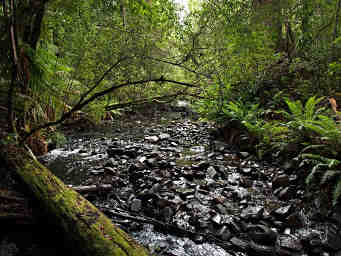 |
| Fungus | Creek |
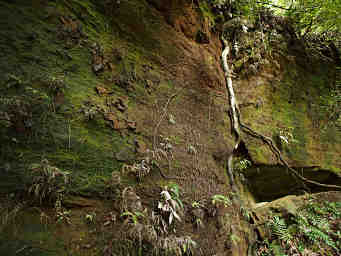 |
| Tree Root (At the time, it had some significance...) |
One of our big goals was to see a Platypus, so every time we came to a creek we would stare up and down it looking for something. The creeks were all pretty dark, discolored by all the tanin in them from the decaying plant matter.
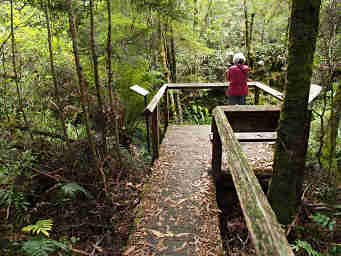 |
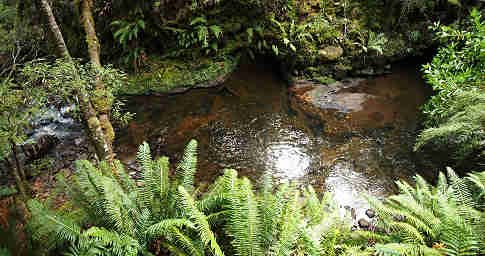 |
| Looking for Platypus | Platypus Territory |
We wandered through a stand of big Eucalyptus trees, several of which had huge burls on them. They made me think of the table our friends brought back from their trip to Western Australia, about six feet in diameter from a big burl.
This particular tree is a "Stringy Bark" Eucalyptus, named for it's obvious characteristic. This big tree is about 250 years old, and supposedly nearing the end of its life, although I'm not sure I believe the end-of-life part. The bark gives off a flammable gas on hot summer days; in a fire the gas makes a fire that much more intense. When they burn, the tree is often not killed, and we saw many old trees with fire scars.
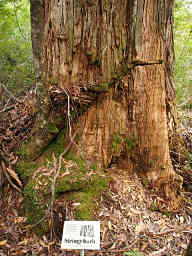 |
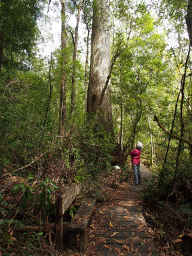 |
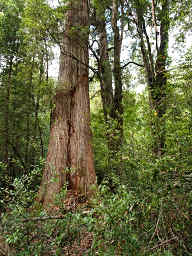 |
| Stringy Bark Eucalyptus |
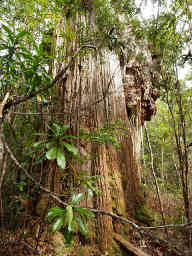 |
 |
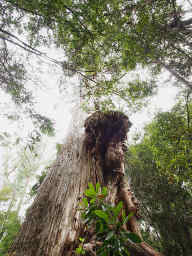 |
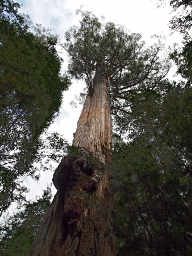 |
| Stringy Bark Eucalyptus Burl |
One of the interpretive signs said most of the trees along the road we were following burned in the 1967 bushfire. In that fire, according to Dick Richardson, a forester,
"A fire swept down out of the Blue Hills, the other side of this road, on Black Tuesday of '67 and Geeveston's crack fire crew chose here to fight it. But they got trapped. A crown fire all up above them all, all around.
They had nowhere to go and nothing to save them. The crew of eight men were led by Macca Russell, he was superbly experienced at firefighting. He got the two dozers to dig a hole and park over the top of it. All the men got underneath and the fire swept over them. He saved them all."
Wow! That's some story, and one resourceful guy.
We found one big old tree with a built in wrap-around seat. It was pretty cool; looked like a great place to curl up with a book and wait see what wandered by.
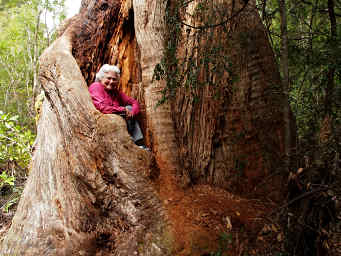 |
 |
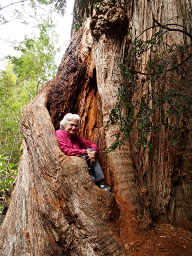 |
| Dona in Big Eucalyptus |
There was usually a big pile of cast off bark at the base of the stringy-bark trees. Perfect fire starter or nest lining. Mixed in with the big trees were some pretty big ferns.
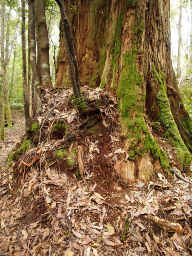 |
 |
| Stringy Bark Litter | Big Fern |
One of the places we stopped had a boardwalk up to and around a huge old Stringy-Bark Eucalyptus tree. I don't think the sign said how old it was, but it was surely a lot more than 250 years...
The Stringy-Bark trees don't lose their bark uniformly; only part of the tree sheds its bark. So there is often a noticeable line where the bark shedding stops.
 |
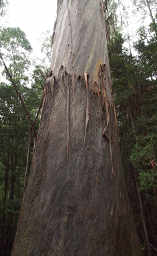 |
| Eucalyptus Giant | Stringy Bark
Transition |
 |
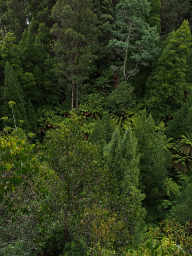 |
| Mixed Temperate Rainforest |
The air walk itself is located beside the Huon River, which runs relatively clear but dark brown from all the tanin in it.
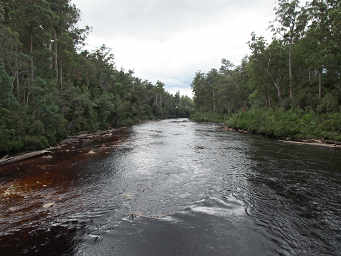 |
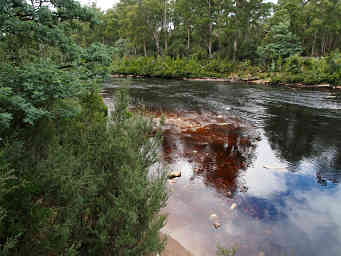 |
| Huon River |
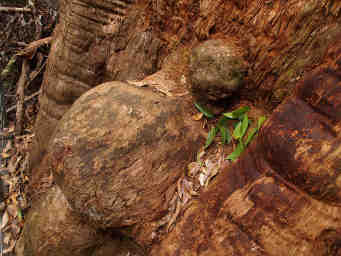 |
| Eucalyptus Burl |
The Air Walk is a big engineering feat, and looks sort of like a giant kid's erector set project.
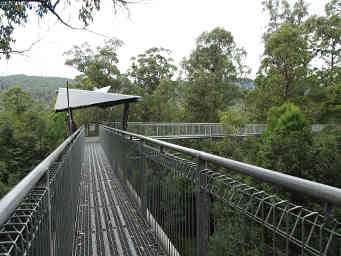 |
 |
| Air Walk |
At one point from the air walk you look down on a big tall tree stump. People have pitched coins down onto it, sort of a forest equivalent of a wishing well. Many of the trees were huge, and towered far above the walk itself. It was difficult to get your mind in sync with the scale of things.
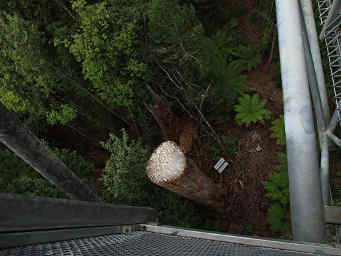 |
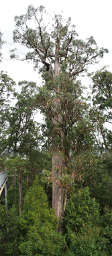 |
| Wishing Tree | Big Eucalyptus |
You had a great view of the Huon River from the air walk; upstream you could see the confluence of the Huon and the Picton Rivers.
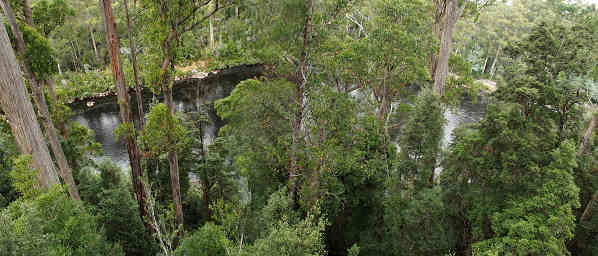 |
| Huon River from Air Walk |
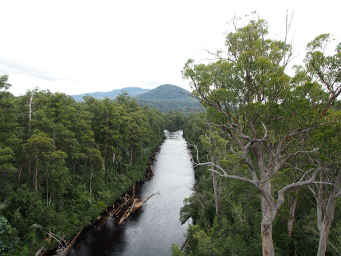 |
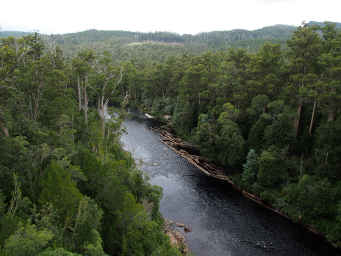 |
| Huon and Pictor River Confluence | Huon River |
The very end of the air walk is a cantilevered section which hangs out over space.
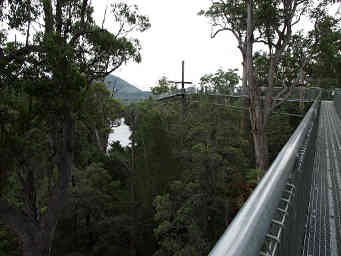 |
| Cantilevered End of Air Walk |
We hiked upstream to where there are two suspension bridges, one across the Huon and one across the Picton River. All of these engineering marvels weren't nearly as much fun as the bridges in Borneo. The Borneo ones were smaller, more crudely made using wood for everything but the cables; they swung in the breeze and bounced up and down a lot when you walked on them. You paid attention when walking across them, lest you slip and fall through the sides. These were guyed to stabilize them, and made of galvanized steel all around; you could pretty much run across them blind-folded and not worry too much.
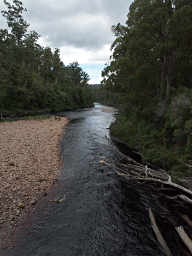 |
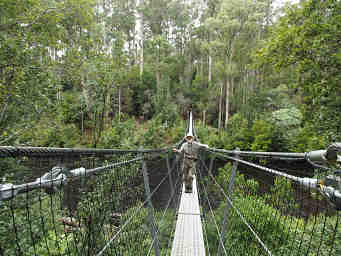 |
| Huon or Picton River | Suspension Bridge |
Then we walked around the "Huon Pine Loop," which was more fun for us than the air walk itself. This was a small loop through temperate rainforest by the river, in an area where there were still a few Huon Pine trees.
The Huon Pine is a very valuable timber tree. It has straight grain, and contains natural oils that resist rotting. It was prized for ship-building and many other purposes. The Huon Pine is very slow growing, and only grows near rivers. Since most of the early timber operations accessed the forest via rivers, there is little old growth Huon Pine remaining. On our walk we passed some trees about 150 years old, and they were small -- they looked about the size of a 25 year old Eucalyptus tree.
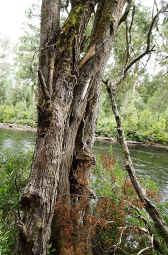 |
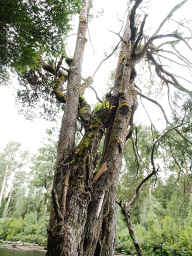 |
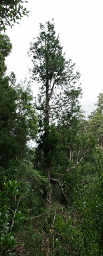 |
| Base of 150 year old Huon Pine | Top of 150 year old Huon Pine | Huon Pine |
The rainforest was full of some of the largest fungi I have ever seen. There were Blackwood trees as well, a member of the Acacia family. It is widespread in Tasmania, and has gorgeous wood, prized by furniture makers and artists.
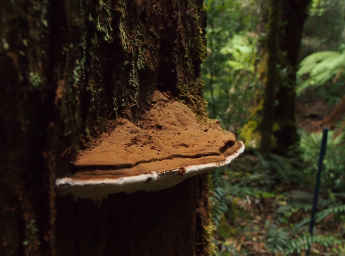 |
 |
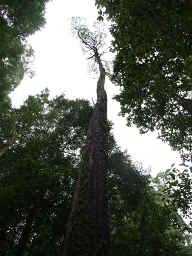 |
| Fungus | Blackwood Tree |
Then we headed back to Hobart. On the way home, we stopped at a woodturner's shop and picked up a bunch of things we had no room to carry home... We also picked up a few apples. Like many rural places, there was a fruit stand without any person to take your money. There was just a jar sitting there. It was nice to be in a place where people generally trusted one-another.
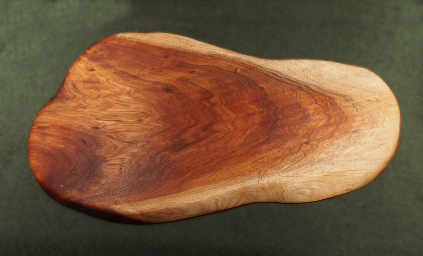 |
| Blackwood Board |
The lower part of the Huon River is slow and probably tidal. There were sailboats anchored all up and down it, and it made me itch to go sailing again.
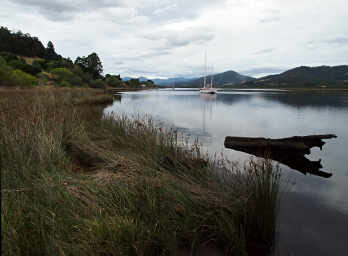 |
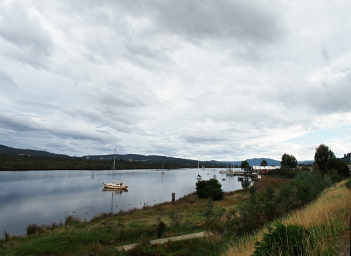 |
| Huon River |
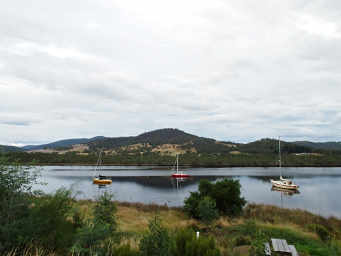 |
| Huon River |
Once home, we checked the weather forecast for the weekend. It was good, and we convinced Frapps and Deirdre and Claire to accompany us on a camping trip. After much debate on where to go, we headed for Mt. William National Park in the northeast.